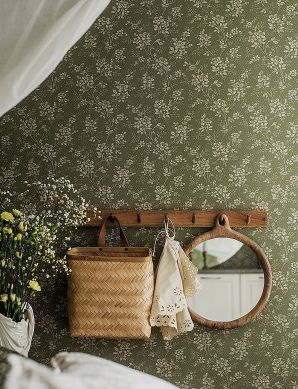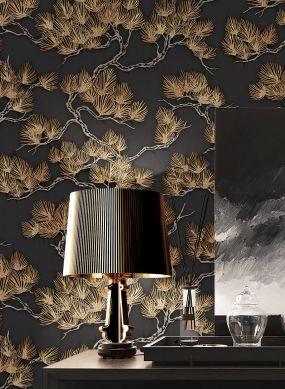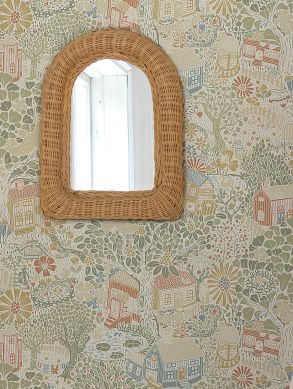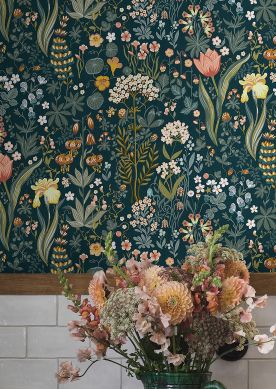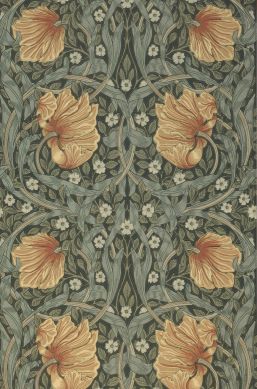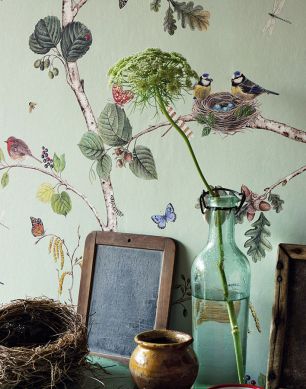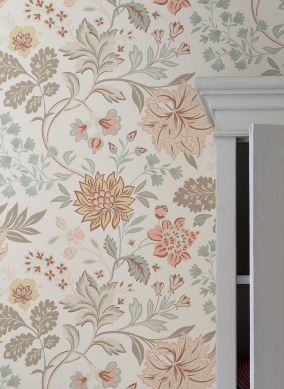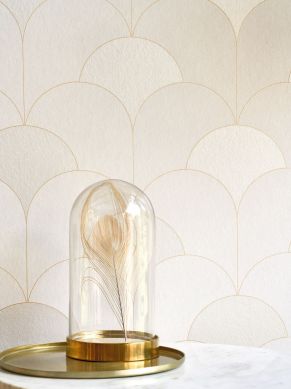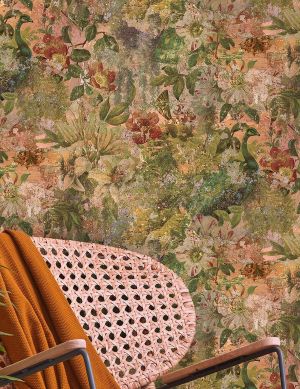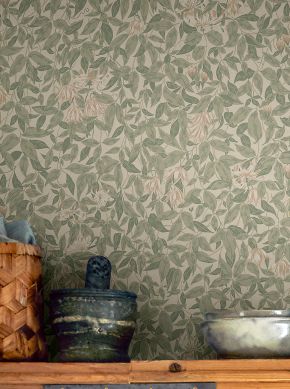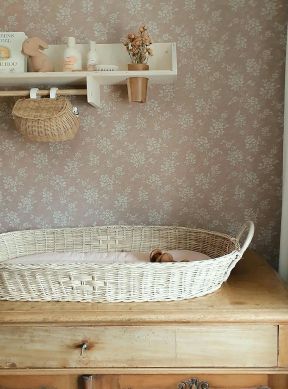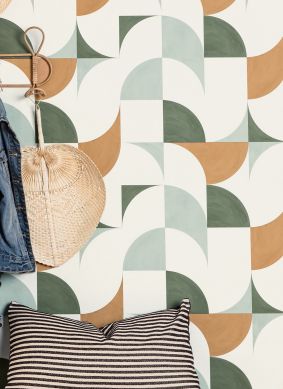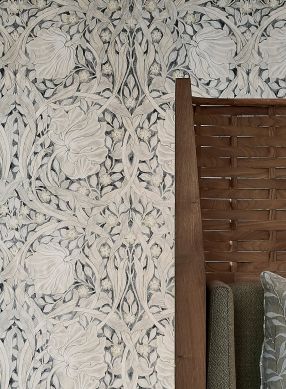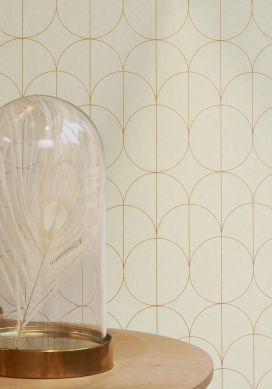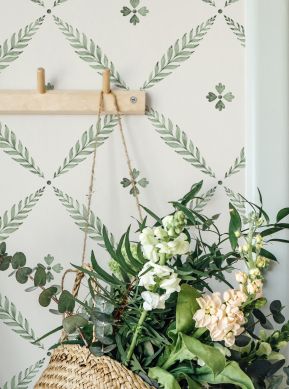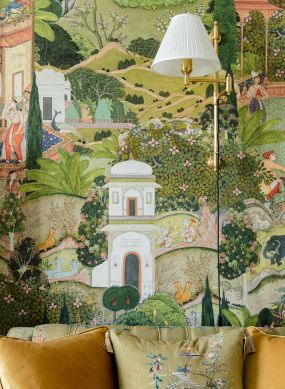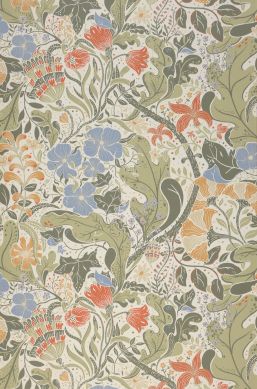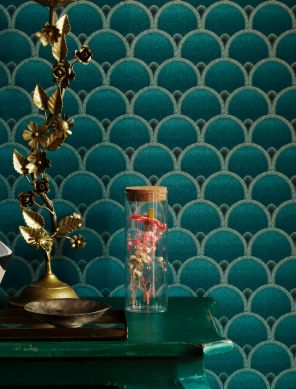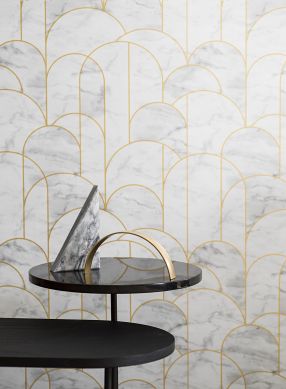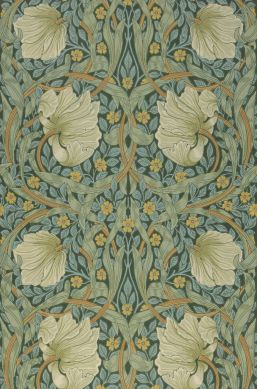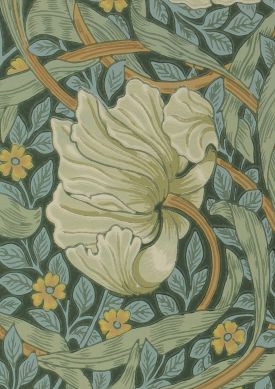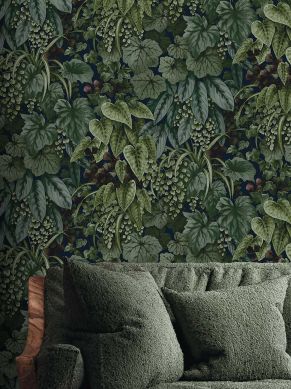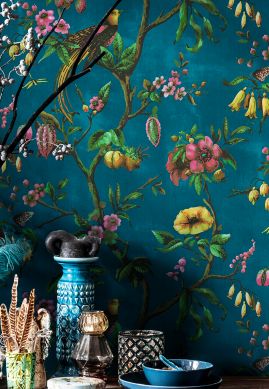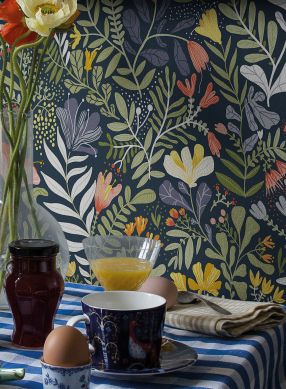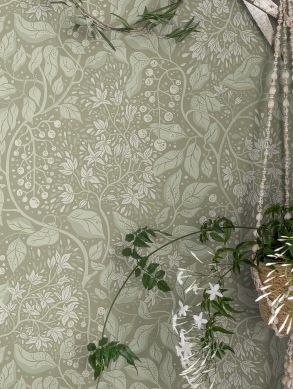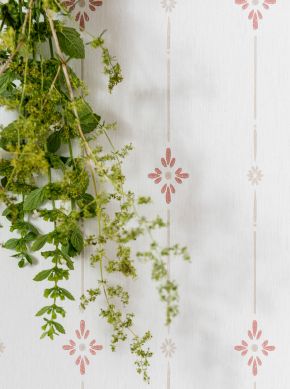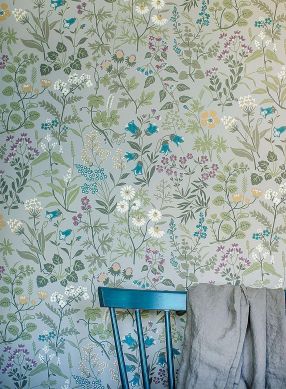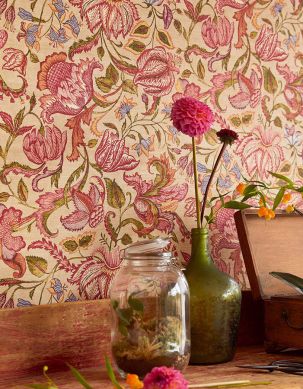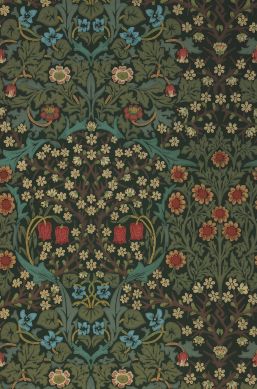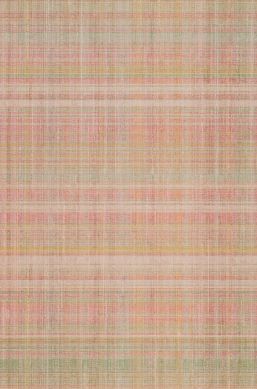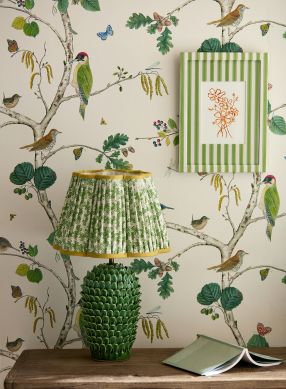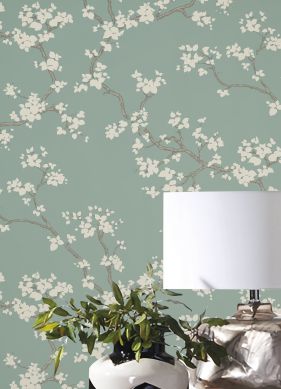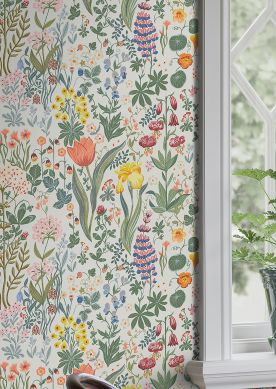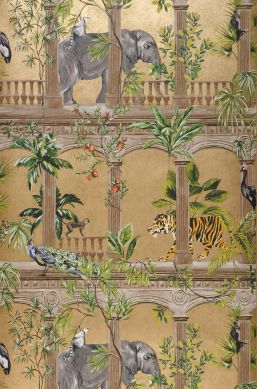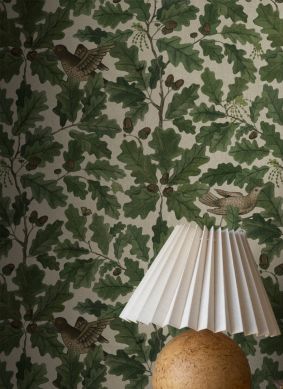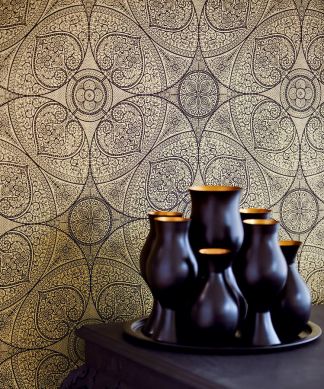Kitchen Wallpaper
Kitchen wallpaper - The Guide
There is barely another room in the house that has experienced more of a societal change in the last century than the kitchen. What was once merely a functional area for the preparation of food has turned into a busy hub of conviviality for family, friends, acquaintances, budding chefs, and foodies. Creating big and small culinary delights, enjoying the odd treat, having a chat, experiment with food - the kitchen is a multi-functional space.
The interior design options matching these requirements are cheerful, colourful, extravagant, sometimes unusual. They meet the need for pleasure, a sentiment that is intrinsically linked with the kitchen. And the prerequisites for true enjoyment are a great atmosphere and a suitable ambience. Design wallpaper helps to create tasteful kitchen environments.
Table of Contents
- A lick of paint or wallpaper for the kitchen?
- Which types of wallpaper are suitable for kitchens?
- Are washable wallpaper models available for kitchens?
- How can wallpaper be made washable?
- Can wallpaper be used for the splash-guard area in kitchens?
- Can wallpaper be applied directly onto tiles?
- What are the specific processes for putting up wallpaper in kitchens?
- How can kitchen wallpaper be cleaned?
- Which colours are suitable for kitchen wall décor?
- How do I choose the best wallpaper for my kitchen?
- Why are wallpaper models with low flammability characteristics a good choice for kitchens?
- Can the fronts of kitchen cupboards and other kitchen furniture be wallpapered?
- Our tips: How to make your kitchen truly appetising
A lick of paint or wallpaper for the kitchen?
Individual factors like room layout, kitchen furnishings and personal preferences determine the design options for kitchen walls: painted walls, design wallpaper, or a combination of both.
Painted walls
Painting the walls is generally the best option for kitchens where the wall space features many windows, alcoves, recesses, or bay windows. Pattern wallpaper models are usually unsuitable for these walls as their effect will be limited. Unusual or flamboyant kitchen furnishings with elaborately structured or highly designed fronts also demand a certain understatement when it comes to wallpaper options.
These types of kitchens benefit from a clever choice of colour(s). Fruity, appetising and fresh hues like kiwi green, orange, raspberry red, chocolate brown or caramel are all great. Combining two colours matching the kitchen furnishings is another popular choice. In terms of paint, the focus should be on non-toxic, washable products. In our Shop, you will find special lining paper which provides the perfect surface for paint and can be painted over repeatedly.
Design wallpaper
Pattern wallpaper can fill the room with a very special (e.g. themed) atmosphere. For instance, using graphical/geometric pattern wallpaper on all walls sets the scene for the Country House or Scandinavia look. Wood, stone, and tile models add to the authentic effects of various themes like, for example, an atmospheric Spanish kitchen. The most important factor for wallpapers and for paint in kitchens is washability.
Combining paint and design wallpaper
Fresh, stimulating wallpaper designs and matching paint are a great combination in the kitchen. A feature wall, perhaps with a large-scale, eye-catching pattern, is a fabulous way to add interest and draw the attention to a specific area, e.g. the cooking space, dining area or coffee bar. The remaining walls can be painted in a matching or contrasting colour. Ideally, a colour picked from the wallpaper design should be used. For each of your wallpaper models, we provide colour codes for matching wall paint. If you're looking for a stunning design highlight for painted kitchen walls, how about replacing the tiled splash-guard with a striking (washable) design wallpaper?
Which types of wallpaper are suitable for kitchens?
The composition of carrier and surface materials determines whether or not a specific design wallpaper model is suitable for the kitchen. It has a major effect on the wallpaper's inherent stability, adhesion and cleanability.
Paper-based wallpaper
Depending on the surface material, paper-based models can be suitable, at least to a limited extent. We recommend treating the wallpaper with a water-repellent wallpaper protection product if the surface consists of paper or other open-pored materials.
Non-woven wallpaper
Wallpaper models with a non-woven carrier layer come with a plethora of surface materials. The best choice are pure non-woven types. Nevertheless, adding a protective layer is a good idea because it provides better moisture resistance and cleanability.
Vinyl wallpaper
Vinyl wallpaper types are perfectly suited for kitchens. The carrier layer can be either a non-woven material or paper. The decorative surface layer is treated with a water-repellent synthetic coating which makes thorough cleaning possible.
Are washable wallpaper models available for kitchens?
The cleanability of wallpapers is determined by the specific degree of moisture permeability. The denser the surface sealing, the better its cleaning properties. Wallpaper models with a synthetic coating provide the best cleaning potential.
Spongeable
Spongeable wallpaper types absorb moisture - a no-no in the kitchen as it leads to the wallpaper peeling off the wall, and cleaning it with a damp cloth or sponge is impossible. Spongeable wallpaper models have no sealant or synthetic layer. Only fresh traces of wallpapering paste can be wiped off carefully during the wallpapering process. Without an additional protective coating, there is zero washability.
Washable
Washable means that the wallpaper surface has been treated with a dense sealing coating which makes it possible to remove water-soluble stains or dirt with a damp cloth or sponge. In order to remove more stubborn stains, e.g. those containing fat, an additional protective coating is necessary.
Super-washable
Super-washable wallpaper models have a distinctly stronger surface sealing. This means that even (fresh) fatty stains can be removed with a damp cloth or sponge and some mild soap solution.
Scrubbable
A robust synthetic coating provides the best possible protection against moisture and the highest level of cleanability. Scrubbable wallpaper models can be cleaned with a damp cloth, sponge or brush and mild detergent or scouring agent.
How can wallpaper be made washable?
A special sealing fluid closes the open pores of a large number of moisture-permeable wallpaper types, thus considerably increasing the level of cleanability. Only very few surface materials are not suitable for this treatment.
Applying liquid wallpaper protection products
Liquid, colourless wallpaper protection products (available in our Shop) close open-pored surfaces, making them moisture-impermeable. They are applied with a roller and should be left to dry thoroughly. No steam should be allowed to develop during the drying process as this will slow it down and have a negative impact on the consistency of the protective coating. Reapplying the liquid increases humidity protection and cleanability.
Sensitive or delicate surface materials should not be treated with liquid wallpaper protection products as, due to chemical reactions, this can have a negative impact on their appearance. This includes natural materials like grass, bamboo or cork, textile fibres, glass beads, metal and effect foil models. You can find more detailed information in our Guide How to seal wallpapers to make them dirt-repellent and washable. Please feel free to contact us if you have any further questions.
Can wallpaper be used for the splash-guard area in kitchens?
The splash-guard which protects heavily used areas around the cooker and sink from fat and water doesn't necessarily have to come in the shape of tiles. Refined pattern wallpaper models can do the job perfectly well, too.
Scrubbable vinyl wallpaper
Due to their robust synthetic surface, scrubbable wallpaper models can withstand water but also hot fat or sauce splashes. They remain undamaged and can be cleaned thoroughly with a mild detergent or scouring agent and a soft brush or sponge.
Glass splash-guard for wallpaper types with a delicate surface
With a transparent glass panels or glass cladding, any wallpaper model can be used as it is protected. Possible options are single-pane safety glass or acrylic glass. Acrylic glass cannot be used next to a gas cooker or any open flames as the heat would damage the material.
Can wallpaper be applied directly onto tiles?
It is not possible to put up wallpaper on old tiles without some preparation. To make sure that the wallpaper adheres to the wall, the surface has to be even and adhesive.
Wallpapering tiled walls in four steps
- First of all, all grouting, clearly visible cracks, and larger holes need to be filled to create an even surface. Once the filler has dried, the surface is sanded/polished. Any dust resulting from this smoothing-out process has to be removed.
- After a thorough clean, the next step is to apply appropriate dispersion adhesive. This also replaces the primer.
- To optimise the pre-prepared surface, lining paper is put up (available in our Shop). This covers small cracks or other minor damages. On darker tiles, the lining paper balances out the colour and prevents it from coming through to the surface.
- The last step is putting the design wallpaper up on the lining paper. Use the adhesive listed in the insert label, adding 20% dispersion glue. For heavier wallpaper models, increase the percentage of dispersion glue.
What are the specific processes for putting up wallpaper in kitchens?
The determining factor for this process is the carrier material (paper or non-woven). Depending on the type of carrier, the adhesive is applied to the back of the strip of wallpaper or directly to the wall.
Technique for applying adhesive directly to the wall
For non-woven wallpaper varieties, the adhesive is applied to the wall. This should be done separately for each length of wallpaper to prevent the paste from drying. A special adhesive is required for non-woven wallpaper types. In wet rooms or for heavier wallpaper models, some dispersion glue is added to increase the adhesive strength.
Technique for applying adhesive to the back of the strip of wallpaper
For wallpaper models with a paper carrier layer, the wallpapering paste is applied to the back of the pre-cut length. If the wall surface is very absorbent, a thin layer of paste can be applied to the wall to increase adhesion. Before the strip of paper-based wallpaper can be put up on the wall, a specific soaking period must be observed. The reason for this is that the wallpaper will expand once it is wet. This expansion needs to be uniform and even, and as long as the soaking time for each strip is identical, air bubbles or creases on the wall can be avoided.
How can kitchen wallpaper be cleaned?
Generally speaking, only washable wallpaper should be used in kitchens. The degree of cleanability determines which stains can be removed, how the wallpaper can be cleaned, and which cleaning agents can be used.
Washable wallpaper (water-repellent)
The denser the surface sealant, the better the protection against moisture as well as the cleanability. Highly washable and scrubbable wallpaper models are the best choice as they provide the best cleanability characteristics. Washable wallpaper types are divided into the following sub-categories: washable, super-washable, and scrubbable. The relevant classification determines the way stains can be removed and what tools and cleaning products can be used.
Clean, lukewarm water, soapy solution, mild cleaning and scouring agents (without bleaching substances) are the available options (depending on cleaning characteristics). Aggressive cleaning products, vinegar, citric acid or other traditional household remedies cannot be used as they will irreversibly damage the surface. Possible tools are soft cloths, sponges or brushes - again, depending on cleanability characteristics. Rubbing is absolutely taboo for all surfaces with synthetic coatings.
Which colours are suitable for kitchen wall décor?
Colours for kitchens should be fresh, fruity, appetising, enjoyable, and warm. Having said that, some elements of the colour scale are top of the list for creating atmospheric kitchen flair.
Green
Green reminds us of healthy herbs, tasty vegetables or delicious fruit. This association with the countless ingredients of a balanced diet is sufficient reason to choose this colour, for instance in nuances like sage or lime green. Green stands for freshness and growth, it gives wings to creativity whilst at the same time creating a sense of balance.
Yellow
Just like the sun, yellow simply spreads happiness and joy. This appetising, cheerful colour fills the kitchen with the effervescence of a zesty lemon whilst simultaneously adding warmth and comfort. Lighter shades of yellow create a sense of space and brightness in small kitchens.
Red
The colour of passion and love is perfect for kitchens with an ambience of pleasure and conviviality. Appetising hues like tomato, cherry, Bordeaux, or chilli red take us on a journey to the garden of culinary delights. Creative hobby chefs can explore their true potential in a kitchen adorned with red wall décor, just as long as the chosen shade isn't too intense.
Blue
The colour of the ocean adds a Mediterranean touch to the kitchen and exudes holiday vibes. Friends of international cuisine will enjoy shades of blue as the colour creates the perfect scene for sampling exotic dishes. In addition, blue has a calming, cooling effect - a great asset in hot kitchens.
Grey
Grey, often combined with white, black, and chrome, is an all-time classic for clean, modern kitchen looks. It also makes any bright colour really pop. Sober, elegant, neutral, deep - depending on the degree of brightness and the context, grey can unfold a plethora of effects in the kitchen and allow for any number of individual interior design ideas.
Orange
Orange is an incredibly popular kitchen colour as it stands for enjoyment and pleasure. It's cheerful, fruity, and sweet and demonstrates a penchant for unconventional extravagance. Orange wallpaper designs promote the appetite as well as open and positive communication; they are the perfect backdrop for a hearty meal, a tasty snack, or a colourful cocktail.
How do I choose the best wallpaper for my kitchen?
Patterns and motifs in many different styles can create an atmospheric and authentic ambience. We have the right wallpaper for any taste or individual preference.
Modern
Modern wallpaper designs are not tied down to any specific patterns or styles. A whimsical lobster motif is as much a possibility as a pattern wallpaper with exotic fruit or animals. Abstract flowers, 3D geometry or unusual ornaments are also contenders. Contemporary furnishings will add to the impact of the wallpaper.
Country House
There are as many region-specific (French, German, American, Mediterranean, etc.) country house looks as there are related wallpaper designs. Romantic flower patterns (e.g. Millefleurs) are as suitable as classic geometric designs (stripes, squares, diamond shapes) or natural florals. Material imitations, e.g. wood, tiles, brick, can be a fabulous addition to an authentic country house style.
Vintage and Retro
When vintage and retro designs adorn the kitchen walls, a certain whimsy and nostalgia are introduced into the room, creating a very special mood. Large-scale geometric patterns, arty or modern designs of the 50s, 60s and 70s, and Flower Power motifs are typical for this style.
Stone and brick imitation designs
Indestructible and yet really cosy materials as seen in country/historical kitchens throughout the ages haven't lost any of their appeal and work perfectly in 21st century kitchens, too. Stone look wallpaper models, e.g. brick, sandstone, clinker, or even concrete, exude a sense of stability and durability whilst with the right furniture, they can also have a totally contemporary effect.
Imitation marble
High-quality marble is sheer understated luxury. Deceptively real, extravagant imitation marble wallpaper models are the way to realising elegant and glamorous kitchen designs ideas. Modern, imaginative marble structures and colours create spectacular effects for walls.
Tile imitation
Many kitchen design concepts are based on examples from other countries near and far. Artistic Spanish Majolica-style tiles, oriental ornament tiles, Delft tiles from Holland, Roman frescoes - these are just some examples for the huge potential provided by tile imitation wallpaper.
Wallpaper patterns with fruit, herbs and vegetables
Wallpaper designs which directly refer to kitchens, for instance those depicting the wonderfully colourful and fresh produce being prepared there, are an extremely popular choice. Cooking will be a joyful experience in such an environment. Herbs of any kind, brightly coloured vegetables, or fresh fruit all have a stimulating effect.
Stripes
Stripe wallpaper models come in a plethora of variations and are a classic design element in many country/Mediterranean styles. The traditional blue-and-white stripe design features in country kitchens on the Baltic or North Sea shores as much as on the French coast. In Britain, subtle colours and stripes of different widths, sometimes in combination with romantic flowers, are the preferred variety. In Scandinavia, purist stripe patterns in cool hues are the most popular choice.
Why are wallpaper models with low flammability characteristics a good choice for kitchens?
Naturally, the kitchen is where cooking takes place, and that implies heat and increased fire risks (open flames, electric cooker and other electric devices, power sockets, etc.). Wallpaper types with low flammability are treated with substances that will stop them from catching fire or delay the process.
Potential sources of fire in kitchens
All manner of electrical devices are used in kitchens, and many of them - with cookers and microwaves at the top - can develop excessive heat. Some kitchens feature gas cookers, and an open flame obviously increases the risk of fires resulting from incorrect or careless handling. In addition, in every kitchen there is a number of power sockets, and they can cause fires due to short circuit situations or defect devices being connected to them. It is therefore a wise move to choose kitchen wallpaper with low flammability in order to increase fire safety.
Fire protection classification "Low flammability"
Construction materials (including wallpapers) are classified according to DIN standard 4102-1. The characteristic "low flammability" corresponds to Fire Protection Class B1, which is often required in public or commercial buildings. Wallpaper types with the label "low flammability" are treated with substances that significantly delay the process of catching fire. This means that in case of a fire, there is more time to prevent the worst outcome. Once the source of the fire has been removed, the wallpaper extinguishes itself.
Can the fronts of kitchen cupboards and other kitchen furniture be wallpapered?
Turning old into new - washable wallpaper types are a great way to upcycle kitchen furniture. This will give your kitchen a unique "facelift" without breaking the bank.
Design concepts with washable wallpaper models
Furniture, furnishings and accessories can be turned into unique treasures by adding design wallpaper. Washable vinyl wallpaper models are the best option when it comes to beautifying and upcycling cupboards and other pieces of furniture. Paper and non-woven types which have been treated with a water-repellent coating are also possible as their cleanability is much improved.
Decorating kitchen furniture with wallpaper
The fronts of pieces of furniture or cupboards can consist of a variety of different materials. For decorative projects with wallpaper, wood or plastic surfaces are best suited. Cupboard doors can be taken off. This makes preparation and glueing easier.
In order to create the best possible adhesion conditions, smooth furniture surfaces have to be sanded down first. After cutting the wallpaper to the specific required measurements, the adhesive is applied, based on the carrier material (non-woven/paper). For models with a paper carrier, the required soaking time must be observed. Take your time attaching the wallpaper to the furniture surface and remove air bubbles and crinkles as soon and as thoroughly as possible. You can find more detailed instructions in our Guide How to decorate furniture with wallpaper.
Our tips: These ideas will make your kitchen truly appetising
- Beautiful contrasts for a white kitchen: The stronger the contrast with the wallpaper, the more striking will the white kitchen furniture (as well as the wallpaper) appear. Amongst some of the best and most impressive options are black, aubergine, fuchsia, turquoise, apple-green, copper-red, and petrol.
- A cooking island or breakfast bar can serve as a fabulous eye-catcher. Unusual, three-dimensional, or opulent pattern designs are great choices.
- A colourful tropical pattern motif can serve as a reminder of culinary holiday treats. The motif choices are endless, for example: cockatoos, parrots, flamingoes, banana or palm trees, to name but a few. In many cases, an imaginative feature wall provides sufficient inspiring interest.
- Pinboard Deluxe: Appointments, shopping lists, notes, photographs, holiday souvenirs, post cards, gig tickets - all of these items and more are often found on kitchen walls. Use the appropriate pattern wallpaper to turn this chaotic hotchpotch into an attractive eye-catcher, adding more of the little things that make a life as time passes.


